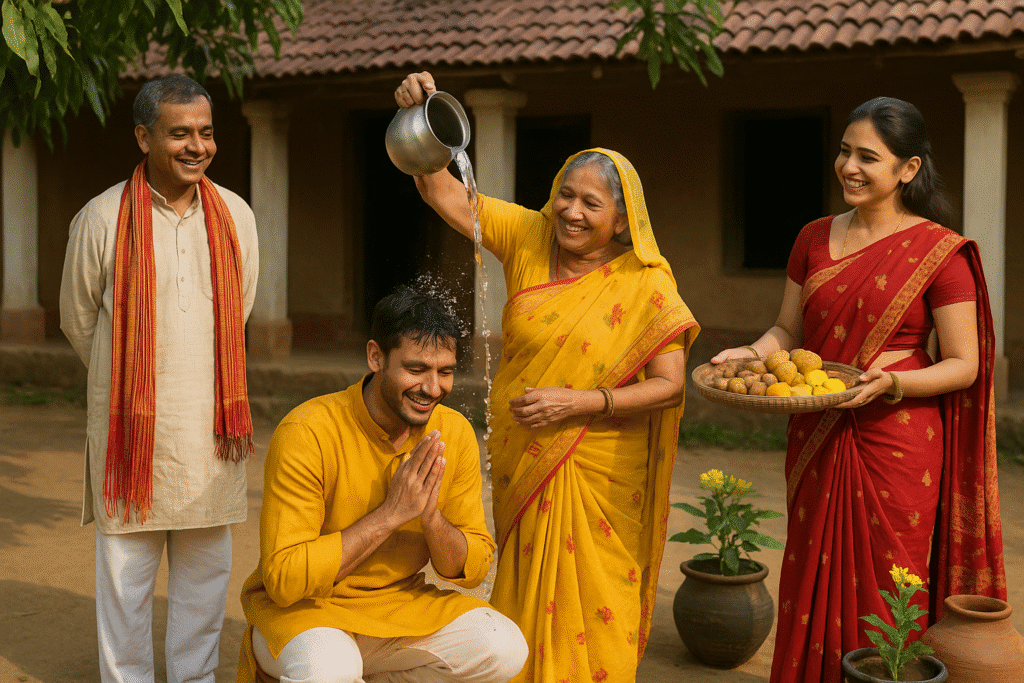Introduction
JurShital, also known as Jur Sital or Jude Sheetal, is a vibrant festival celebrated in the Mithila region of Bihar, India, and parts of southern Nepal, marking the Maithili New Year and the arrival of spring. Observed on April 14 or 15, coinciding with Mesha Sankranti (the Sun’s transition into Aries), this festival is a cultural tapestry of gratitude for the harvest, reverence for nature, and strengthening of community bonds. Known as “freezing cold” in Maithili, JurShital combines unique rituals like watering plants and animals with joyous celebrations, offering a refreshing contrast to the scorching summer. This article delves into the festival’s origins, rituals, and modern significance, highlighting its role in preserving Mithila’s eco-conscious heritage.
Historical and Cultural Roots of JurShital
Origins in Mithila’s Agrarian Traditions
JurShital’s roots lie in the agrarian culture of the Mithila region, where farming sustains communities. Celebrated as part of Satuani, a harvest festival honoring the rabi crop, JurShital marks the Maithili New Year per the Tirhuta Panchang calendar. Folklore attributes the festival to ancient practices of giving thanks for bountiful harvests, with some unverified claims linking it to the birthday of King Shailesh of Mithila. Its alignment with the vernal equinox underscores its connection to seasonal renewal and agricultural cycles.
Significance in Maithili Identity
JurShital is a cultural cornerstone for the Maithili-speaking people, including Maithil, Awadhi, and Tharu communities. Recognized as Mithila Diwas by the Bihar government since 2011, it is a public holiday that celebrates the region’s linguistic and cultural heritage. Unlike religious festivals, JurShital is a secular celebration of nature and relationships, emphasizing ecological balance and communal harmony. Its name, derived from Jur (connected) and Shital (stay cool), reflects its ethos of fostering connections while cooling the body and mind.
Spiritual and Social Significance
Gratitude for Nature’s Bounty
At its core, JurShital is a festival of gratitude, honoring the Goddess of Harvest and the land’s fertility. The Satuani rituals, observed on the eve of JurShital, involve cleaning and resting the chulha (kitchen hearth), revered as Chulha Maharani, to express appreciation for sustenance. This practice symbolizes simplicity and respect for resources, aligning with Mithila’s agrarian ethos. The festival also celebrates the lush green fields that emerge with the monsoon’s approach, signaling a renewed agricultural cycle.
Strengthening Community Ties
JurShital fosters social cohesion through rituals that connect generations and communities. On the second day (Baisakh 2), seniors pour cold water on juniors’ heads as a blessing, a cooling gesture that strengthens familial bonds. The festival’s inclusive nature extends to non-human life, with participants watering plants and animals to honor the ecosystem. These acts reinforce Mithila’s cultural motto of interconnectedness, making JurShital a celebration of relationships and environmental stewardship.
Rituals and Traditions of JurShital
Satuani: The Harvest Prelude
The festival begins with Satuani on April 13 or 14, when women prepare a feast of traditional Maithili dishes, including satuwa (roasted gram flour), known as the “poor man’s protein” for its nutritional value. The chulha is cleaned, adorned with vermilion, and sealed for the day, symbolizing rest for the hearth deity. Families consume basiya khaana (stale food) on JurShital, avoiding cooking to honor the harvest and embrace simplicity. This ritual underscores sustainability and gratitude.
Water Rituals and Blessings
On JurShital day, the pouring of cold water is a central ritual. Elders bless younger family members by sprinkling water on their heads, a cooling act that marks the New Year with goodwill. Participants also water plants, trees, and animals, reflecting Mithila’s ecological consciousness. In some areas, celebrants playfully throw colored silt from water bodies, reminiscent of Holi, adding vibrancy to the festivities. These water-based rituals combat the summer heat while symbolizing renewal and care for nature.
Culinary and Cultural Celebrations
JurShital’s cuisine highlights Maithili flavors, with satuwa mixed with jaggery or yogurt, bori (lentil dumplings) with bhaat (steamed rice), and sondesh (milk-based sweets). These dishes, rich in nutrients like iron and magnesium, reflect the region’s focus on wholesome, local foods. Cultural activities include kite-flying, symbolizing high aspirations, and folk songs that narrate Mithila’s history. Community gatherings and storytelling sessions reinforce Maithili traditions, engaging all ages.
JurShital in Mithila and Beyond
Celebrations in Bihar and Nepal
In Bihar’s Mithila region, encompassing districts like Darbhanga, Madhubani, and Supaul, JurShital is a lively affair. Homes are decorated with rangoli and mango leaves, and streets buzz with kite-flying and water-based revelry. In southern Nepal’s Terai region, Maithili communities celebrate with similar fervor, blending local Tharu and Awadhi customs. The festival’s recognition as a state holiday in Bihar amplifies its visibility, with cultural programs and fairs showcasing Maithili art and music.
Diaspora and Global Reach
JurShital’s spirit travels with the Maithili diaspora to cities like Delhi, Mumbai, and international hubs. Community organizations host virtual events, sharing recipes and folk songs online to keep traditions alive. Social media platforms amplify the festival’s reach, with hashtags like #JurShital and #MithilaDiwas promoting its eco-friendly rituals. These efforts ensure that even urban Maithili youth remain connected to their cultural roots, fostering global appreciation for the festival.
Modern Adaptations and Challenges
Embracing Eco-Conscious Celebrations
JurShital’s focus on watering plants and animals aligns with modern environmental movements, making it a model for sustainable festivals. Community-led initiatives, such as tree-planting drives and water conservation campaigns during JurShital, highlight its ecological relevance. However, urbanization and the influence of larger festivals like Holi threaten its distinct identity. Cultural organizations are countering this by promoting Maithili language classes and traditional crafts during the festival.
Preserving Cultural Heritage
The rise of globalization poses challenges to JurShital’s traditional practices, with younger generations gravitating toward mainstream celebrations. Efforts by the Maithili Sahitya Sansthan and local artists to document Paddanas (folk ballads) and revive Mithila painting during JurShital aim to safeguard its heritage. Schools in Bihar incorporate the festival into curricula, teaching students about its ecological and cultural significance, ensuring its legacy endures.
Lessons from JurShital for Today
Sustainability and Simplicity
JurShital’s rituals, like resting the chulha and consuming leftover food, offer lessons in sustainable living. In an era of overconsumption, the festival encourages mindful resource use and gratitude for nature’s gifts. Its water-based practices highlight the importance of environmental care, inspiring communities to adopt eco-friendly habits year-round.
Building Connected Communities
The festival’s emphasis on blessings and shared celebrations fosters social harmony, a reminder of the power of human connections. By including non-human life in its rituals, JurShital promotes a holistic view of community that encompasses the ecosystem. This inclusive ethos can guide modern societies toward empathy and collaboration across diverse groups.
JurShital and Cultural Tourism
JurShital holds immense potential as a cultural tourism draw, showcasing Mithila’s vibrant art, cuisine, and traditions. Visitors can explore Madhubani paintings, savor satuwa-based dishes, and witness kite-flying festivals in Darbhanga’s historic towns. Promoting JurShital through tourism boards and cultural festivals could boost local economies while raising global awareness of Maithili heritage, positioning Mithila as a cultural gem of eastern India.
Conclusion
JurShital is a luminous celebration of Maithili New Year, weaving together gratitude, nature, and community in the heart of Mithila. From the cooling water rituals to the hearty satuwa feasts, the festival embodies simplicity, sustainability, and cultural pride. As Mithila navigates the challenges of modernity, JurShital stands as a beacon of ecological wisdom and social unity, inspiring us to honor our roots and nurture our planet. Let us embrace this festival’s vibrant spirit, fostering connections that keep Mithila’s heritage alive for generations to come.



